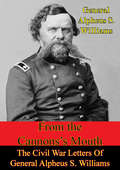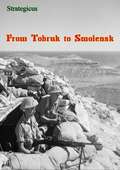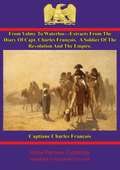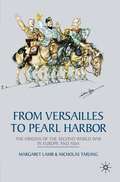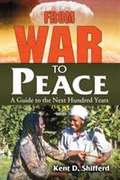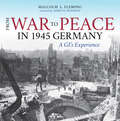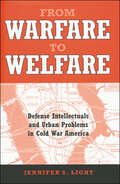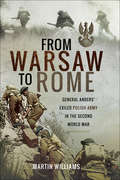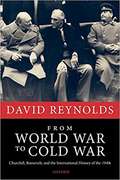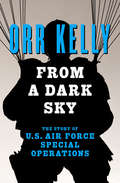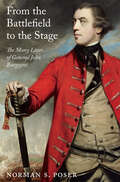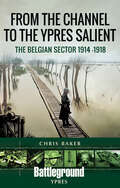- Table View
- List View
From The Cannon’s Mouth: The Civil War Letters Of General Alpheus S. Williams
by Milo M. Quaife General Alpheus S. WilliamsA candidate for the title of "unsung hero" among the Union generals of the Civil War, Alpheus Williams, "Old Pap" to his men, wrote as frequently as he could to his family in Detroit of his successes, achievements and battles during that terrible period of strife. In this engaging collection of his correspondence he recounts the part he played in the battles both East and West at Second Bull Run, Antietam, Chancellorsville, Gettysburg, Atlanta and the Savannah campaign. A kind hearted man, he was deeply affected by the hardships suffered by the common soldiers under his command who he treated with great care and often sorrow at the awful casualties they suffered.Warmly recommended."Superb war letters. . . . Old 'Pap' Williams possessed an unconscious literary flair that gives simple style and force to his letters. . . . Milo Quaife has added annotation that will enlighten the casual reader and satisfy the scholar."--New York Times Book Review"Civil War scholars are always grateful for a volume of letters written by a high-ranking officer who held important commands in pivotal engagements. . . . A superior collection. . . . Especially useful to students of the war are his keen, detailed accounts of Antietam, Chancellorsville, and Gettysburg."--American Historical Review
From This Moment On (Made in Montana)
by Debbi RawlinsHe's one cowboy she can't resistCowboy and lady-magnet Trace McAllister has a problem...and she's petite, with almond-shaped eyes and a body that makes his libido beg for mercy. Sure, the Sundance Dude Ranch has attracted a bevy of gorgeous townie women. But not one draws him in like sexy little Nikki Flores.Nikki isn't looking to play games with some good-lookin' charmer of a cowboy. She knows better-or should. Besides, she's in Blackfoot Falls only long enough to figure out her next move. And the last thing she needs is to get tied down...or tied up!But all they need is one moment-the moment when temptation takes over....
From Tobruk to Smolensk
by StrategicusOriginally published in 1941, this book represents the third volume in a series on the course of World War II, by a well-informed author who chose to remain anonymous during the time of first publication. The period covered in this volume is roughly from February to August 1941. It is the sequel to The War for World Power and From Dunkirk to Benghazi and, according the author's Preface, "has been written upon the same broad lines as an attempt to disentangle from the amazing confusion of events those which are the most significant and, while there has been some endeavour to admit the jurisdiction of chronology, events have been grouped as far as possible in episodes that have a certain unity."It differs from the preceding volumes in showing the decisive character of the operations. From more concentrated though skilful operations it developed into movements which for mass and momentum have no parallel in history. It has the sort of discontinuity that exists between the art of the miniaturist and that of the scene painter; and yet it is evident that the attitudes and outlooks that conditioned earlier military operations dominated these. It can hardly fail to be realized that the attitude towards defence that caused the fall of France would have led to defeat throughout this period and that the Russians escaped defeat and inflicted damage on their opponents in the measure that they attacked and in so far as they failed it was due to their acting upon the defensive."
From Valmy To Waterloo—Extracts From The Diary Of Capt. Charles François: A Soldier Of The Revolution And The Empire.
by Jules Arsène Arnaud Clarentie Robert B. Douglas Capitiane Charles FrançoisThe cannonade of Valmy (1792) ranks as one of the most significant battles of all time for its strategic results: the defeat of the Prussian invasion heralded the beginning of the French Republic. At the field of Waterloo in 1815, no less a battle ended once and for all the ambitions of Napoleon to dominate Europe under French hegemony. Throughout this period of strife and struggle, which would change the map of Europe forever, Capitaine François fought under the banners and eagles of France, a callow youth at the time of Valmy, a grizzled veteran by the time of Waterloo. His story stretches from the plains of Northern France, through the frozen wastes of Russia, the sunburnt sands of Egypt and to the rotting prisoner hulks of Spain. François was by his own account a ruthless, fearless fighter but tempered with a passionate and phlegmatic nature; of the many memoirs of Napoleon's troops, few are filled with such adventure and anecdote.An excellent from the ranks of Napoleon's army.Author -- Capitaine Charles François (1774 or 5-1853.)Preface -- Jules Arsène Arnaud Claretie (1840-1913.)Translator -- Robert B. DouglasText taken, whole and complete, from the edition published in 1906, London, by Everett and Co.Original Page Count - 332 pages.
From Versailles To Mers El-kébir: The Promise Of Anglo-french Naval Cooperation, 1919-40
by George MeltonThis is a ground-breaking study in Anglo-French naval relations after 1919 as they related to European diplomatic currents between the two World Wars, and to the balance of global naval power before World War II until the summer of 1940. The regional focus is on the Mediterranean, the only area where British and French naval power could be combined to support their diplomatic agenda and to restrain the weakest of the three Axis powers. In broader focus, the study suggests that shifting currents in the balance of global naval power left both the French and British fleets overextended in the late 1930’s, so that their concluding an entente was their only option to redress the strategic imbalance. The book is a study of the troubled courtship between the two naval staffs leading to the conclusion in early 1939 of a naval Entente. The Entente enabled London and Paris to distribute their naval power in the Mediterranean to neutralize Italy and Japan and to combine their naval power in the Atlantic against the Kriegsmarine. But that alliance was not an altogether happy one, as the global defense imperatives of the Admiralty frustrated the regional ambitions of the Rue Royale intent upon unleashing combined Anglo-French naval power against Italy to seize control of the Mediterranean early in the war. The study concludes that the Entente enjoyed its greatest success in terms of naval operations in the Atlantic against German surface raiders and U-boats, and that the British attack upon the French squadron at Mers el-Kébir was more a product of the 1940 Franco-German-Italian armistices that of accumulated tensions in the Entente. Finally, the study concludes with the view that the attack upon the French fleet at Mers el-Kébir was a tactical failure and a strategic blunder that burdened the subsequent war effort and created a naval balance more hostile than that prior to the attack, and that the outcome of the operation demanded a carefully crafted cover-up that twisted the facts and concealed from the public the failure of the operation.
From Versailles to Pearl Harbor
by Nicholas Tarling Margaret LambIn 1941, the European war became a world war. This book tackles that process in its economic, political and ideological dimensions. Margaret Lamb and Nicholas Tarling explore the significance of the Asian factor and the importance of East Asia in the making of the war in Europe and the transformation of the European war of 1939 into the world war of 1941. This Asian factor has often been neglected, but the policies of all the major powers were affected by their world-wide interests. France had its possessions in North Africa and Asia; Nazi Germany chose to become involved in China and to make an agreement with Japan; Britain's action in Europe and the Mediterranean were conditioned by its commitments elsewhere in the world, and the United States and the Soviet Union were both involved in Europe and Asia. In particular the threat that Japan presented to the status quo in East Asia made it difficult for the war in Europe in turn affected the position in East Asia. The US built a two-ocean navy and encouraged the British to continue their struggle by keeping the resources of South East Asia available, and these steps led to a clash with the Japanese. Lamb and Tarling's global approach throws valuable new light on the origins of the Second World War.
From Vision To Reality: Implementing Europe's New Security Order
by Trine FlockhartFrom Vision to Reality takes the reader past the fixation with political decision-making by focusing on the process of implementation that follows important policy decisions. The book identifies the intentions behind a collection of key policy decisions for establishing Europe's new security order and investigates whether the implementation of thos
From Volturno To The Winter Line: 6 October - 15 November 1943 [Illustrated Edition]
by AnonIllustrated with 30 maps and 36 Illustrations.BEFORE DAWN ON THE MORNING OF 13 Oct. 1943, American and British assault troops of the Fifth Army waded the rain-swollen Volturno River in the face of withering fire from German riflemen and machine gunners dug in along the northern bank. This crossing of the Volturno opened the second phase of the Allied campaign in Italy. Five weeks earlier the Fifth Army had landed on the hostile beaches of the Gulf of Salerno. Now it was attacking a well-defended river line.Along the Volturno the Germans had entrenched themselves in the first good defensive position north of Naples. Under pressure from the Fifth Army, commanded by Lt. Gen. Mark W. Clark, their rearguards had relinquished the great port of Naples with its surrounding airfields, providing us with the base necessary for large-scale operations west of the rugged Apennine mountain range, backbone of the Italian peninsula. East of the Apennines the British Eighth Army, under General Sir Bernard L. Montgomery, had reached the mouth of the Biferno River during the first week of Oct.. The Eighth and Fifth Armies now held a line across the peninsula running south from Torre Petacciato on the Adriatic Sea for some sixty-five miles, then west to a point on the Tyrrhenian Sea just south of the Volturno. Along this line of rivers and mountains the Germans clearly intended to make a stubborn stand, hoping to delay, perhaps to stop, our northward advance.Within six weeks, Fifth Army troops had driven the Germans back to the Volturno, had executed a difficult river crossing in the face of a well-entrenched enemy, had gone on to cross the river a second and a third time, and had forced Kesselring's hard-pressed army back into the chain of mountains which formed his next strong defensive position. Whether fighting across rivers, through valleys, or up steep mountain slopes, our men had everywhere proved their ability to defeat Hitler's vaunted master race.
From Wakefield to Towton: The Wars of the Roses (Battleground Britain 1460–1461)
by Philip HaighThe Wars of the Roses was a complicated, bloody affair between the houses of Lancaster and York, and witnessed much changing of sides. That disjointed feuding persisted for a staggering thirty years and was a north versus south affair. However, the period and conflicts covered by this title are refreshingly clear. An intriguing tale of treachery and deceit.
From War To Cold War: The Education Of Harry S. Truman
by Robert James MaddoxThis book reviews the strains between the United States and Great Britain that led to the Cold War as the result of personal characteristics of the leaders of the United States, the Soviet Union, and Great Britain as well as of historical and ideological forces.
From War To Peace: A Guide To The Next Hundred Years
by Kent D. ShifferdThe world's first peace organizations emerged in the 19th century and since that time, anti-war activism has progressed rapidly. This illuminating book presents a realistic analysis of the extent to which the war system has infiltrated all aspects of Western culture and how it works to perpetuate war rather than promote peace. Additionally, the text describes the historically recent and still evolving parallel system of peace institutions. The values and ideas that have grown out of peace activism offer a very real opportunity to outlaw war in the coming century just as slavery was abolished in the 19th century.
From War to Forever
by Andria Large2nd EditionDennis The love of my life is dead. Is there a reason to live anymore? I’m a veteran Marine. Terrorists took not only my foot, but also my wife. Recurrent nightmares, a dead-end job, and a painful limp are all I have left. My best friend, Tucker, and my sister, Lizette, keep me afloat. I wouldn’t be here if it weren’t for Tucker… literally. And then, out of nowhere, there are these feelings. The kind I haven’t felt in years. The kind I’m not sure I can handle, or even want to. But they’ve started wrapping around my broken heart, trying to mend it. Only they are not for a woman, but for the man suddenly sharing my bed. I’m not so sure I’m ready to give love another go. Tucker The war took my hearing, but I’m alive. Many of my friends are not. I am building a life with my best friend, Dennis. We have become practically inseparable. And now, we are more than friends. I’ve never had feelings like these for a man. My parents, my brother, my buddy, Duke—will they understand how I feel about Dennis? Can I risk losing my family? First Edition published as At War by KDP Select, 2015.
From War to Peace in 1945 Germany
by James H. Madison Bradley D. Cook Malcolm L. FlemingAs an Official Army Photographer, "Mac" Fleming's assignment was to take motion pictures of significant wartime events for the US Army. In the pouch intended to carry his first-aid kit on his belt, he instead carried a small personal camera, which he used to take pictures of the people and places that interested him, capturing in his field notes details of the life he observed. From these records, Fleming has assembled this absorbing private chronicle of war and peace. Assigned to the European Theater in February 1945, he filmed the action from the battle for the Remagen Bridge across the Rhine, to the fighting in the Hartz Mountains, on to the linkup with the Russian forces at the Elbe River. After the armistice, Fleming helped document how the Allied Expeditionary Force established a military government in Germany to cope with masses of POWs, establish control of the country, deal with the atrocities committed by the German army, and help thousands of newly released slave laborers return home to Poland, France, and Russia. He also recorded how the army provided rest, recreation, and rehabilitation to the remaining US soldiers and sent them home by truck, train, and ship. Awaiting shipment home, Fleming explored postwar German town and country life and toured some famous castles and historic spots. The foreword by historian James H. Madison describes the important role of photography in war and the special contribution of Fleming's photographic diary.
From War to Peace: The Conversion of Naval Vessels After Two World Wars
by Nick RobinsFrom War to Peace tells the story of the adaptation from White Ensign to Red Ensign, and to flags of other nations, of the numerous classes of naval ships mainly built during the two world wars and surplus to requirements with the advent of peace. It also describes ships sourced from the United States Navy and elsewhere that were converted for commercial use. The most successful classes to transfer to the merchant service were the Hunt-class minesweepers of the Great War, Landing Craft, Tank, the salvage tugs of World War Two, and the wooden-hulled Fairmile launches which became familiar at seaside resorts in the 1950s and ‘60s; and, of course, the MFV classes that helped the fishing industry in the postwar years. The story includes the successful commercial conversions of many of the Flower and Castle Class corvettes and River Class frigates, notably the 1954 conversion of HMCS Stormont to a luxury yacht for the Greek shipping magnate Onassis. It describes why HMS Charybdis became a passenger liner in the Great War, and how HMS Albatross nearly became a luxury liner after World War Two, but in fact was transformed into a very unpopular emigrant ship and ended her days as a floating casino based at Cape Town. The author reveals the military antecedents of numerous commercial vessels that many would have thought were built especially for the service that they later maintained, and it illustrates just how many Royal Navy vessels ended up in private ownership. And the question is asked: if the military had not built so many ships that were eminently suitable for commercial adaptation, would the technical development of merchant shipping have progressed at a faster rate than it did? The answer is a definite ‘no’, and is illustrated in several ways. It was former naval vessels that promoted the early development of the Ro-Ro ferry; former naval ships introduced numerous design innovations, for example, the raised foredeck common for so many years on salvage tugs, and, above all, stripped of their military hardware, ex naval ships provided opportunities for modest investment where otherwise there would have been none. Copiously illustrated throughout, the book tells a fascinating story of invention and ingenious ship conversion, and of pragmatic adaptation in the financially stringent years after two world wars.
From Warfare to Welfare: Defense Intellectuals and Urban Problems in Cold War America
by Jennifer S. LightDuring the early decades of the Cold War, large-scale investments in American defense and aerospace research and development spawned a variety of problem-solving techniques, technologies, and institutions. From systems analysis to reconnaissance satellites to think tanks, these innovations did not remain exclusive accessories of the defense establishment. Instead, they readily found civilian applications in both the private and public sector. City planning and management were no exception.Jennifer Light argues that the technologies and values of the Cold War fundamentally shaped the history of postwar urban America. From Warfare to Welfare documents how American intellectuals, city leaders, and the federal government chose to attack problems in the nation's cities by borrowing techniques and technologies first designed for military engagement with foreign enemies. Experiments in urban problem solving adapted the expertise of defense professionals to face new threats: urban chaos, blight, and social unrest. Tracing the transfer of innovations from military to city planning and management, Light reveals how a continuing source of inspiration for American city administrators lay in the nation's preparations for war.
From Warfare to Welfare: Defense Intellectuals and Urban Problems in Cold War America
by Jennifer S. LightThis study of Cold War era urban planning explores how defense technology was employed to reshape America’s cities.During the early decades of the Cold War, large-scale investments in American defense and aerospace research and development spawned a variety of problem-solving techniques, technologies, and institutions. From systems analysis to reconnaissance satellites to think tanks, these innovations soon found civilian applications in both the private and public sector. City planning and management were no exception.Jennifer Light argues that the technologies and values of the Cold War fundamentally shaped the history of postwar urban America. From Warfare to Welfare documents how American intellectuals, city leaders, and the federal government chose to attack problems in the nation’s cities by borrowing techniques and technologies first designed for military engagement with foreign enemies. Experiments in urban problem solving adapted the expertise of defense professionals to face new threats: urban chaos, blight, and social unrest. Tracing the transfer of innovations from military to city planning and management, Light reveals how a continuing source of inspiration for American city administrators lay in the nation’s preparations for war.
From Warsaw to Rome: General Anders' Exiled Polish Army in the Second World War
by Martin WilliamsIn May 1944, 40,000 Polish soldiers attacked and captured the hilltops of Monte Cassino, bringing to a close the largest, bloodiest battle fought by the western Allies in the Second World War. Days later the Allied armies marched into Rome seizing the first Axis capital.No-one in 1939 could have foreseen an entire Polish Corps engaged on the Italian Front. Most had been held prisoner in the USSR following Polands defeat and their release by Stalin was only achieved through the intense negotiations of British and Polish politicians generals, notably Sikorski and Anders,. The Polish Army was evacuated to Iran in 1942 and subsequently incorporated into the British Army as the Polish II Corps. Their ultimate postwar fate was shamefully ignored until too late.This book, which charts the extraordinary wartime story of the exiled Polish Army in the east, makes extensive use of undiscovered archive material. It reveals in depth the relations between the British and Polish General Staffs and the never ending hardships of the Polish soldiers.
From World War to Cold War: Churchill, Roosevelt, and the International History of the 1940s
by David ReynoldsThe 1940s was probably the most dramatic and decisive decade of the 20th century. This volume explores the Second World War and the origins of the Cold War from the vantage point of two of the great powers of that era, Britain and the USA, and of their wartime leaders, Churchill and Roosevelt. It also looks at their chequered relations with Stalin and at how the Grand Alliance crumbled into an undesired Cold War. But this is not simply a story of top-level diplomacy. <p><p> David Reynolds explores the social and cultural implications of the wartime Anglo-American alliance, particularly the impact of nearly three million GIs on British life, and reflects more generally on the importance of cultural issues in the study of international history. This book persistently challenges popular stereotypes - for instance on Churchill in 1940 or his Iron Curtain speech. It probes cliches such as 'the special relationship' and even 'the Second World War'. And it offers new views of the familiar, such as the Fall of France in 1940 or Franklin Roosevelt as 'the wheelchair president'. <p><p> Incisive and readable, written by a leading international historian, these essays encourage us to rethink our understanding of this momentous period in world history.
From a Dark Sky: The Story of U.S. Air Force Special Operations
by Orr KellyA fascinating history of the most secretive and unsung branch of the US military&’s Special Forces, from World War II through Desert StormVery little is known about USAF Special Operations—yet their exploits have been as daring and their achievements as remarkable as anything accomplished by their brother warriors. Since World War II, these ultra-secretive &“air commandos&” have routinely performed the near-impossible, undertaking missions that typically carry them across enemy lines. From secretly inserting covert operatives into North Korea and participating in clandestine CIA operations in Vietnam and Cambodia to providing air support for partisans in Nazi-occupied France and rescuing dozens of downed fliers trapped deep in enemy territory, these courageous airmen have done the jobs that no one else could do, often in the most technologically advanced war machinery the Air Force has at its disposal. Sometimes called &“ravens&” or &“carpetbaggers,&” the air commandos have a history that has long been buried beneath layers of official cover stories, rumors, and deceptions—until now.An expert in military affairs, Orr Kelly has already written what many believe to be the definitive history of the US Navy SEALs (Brave Men, Dark Waters). Now, he turns his attention to this unsung branch of the military&’s Special Forces, relating a true story of courage, skill, and commitment that spans decades. With uncompromising honesty, he explores both the triumphs (Project 9 in Burma) and the disasters (the failed rescue of hostages in Iran) of these incomparable heroes of the sky, who have never sought recognition or glory.
From a Dark Sky: The Story of U.S. Air Force Special Operations
by Orr KellyA fascinating history of the most secretive and unsung branch of the US military&’s Special Forces, from World War II through Desert StormVery little is known about USAF Special Operations—yet their exploits have been as daring and their achievements as remarkable as anything accomplished by their brother warriors. Since World War II, these ultra-secretive &“air commandos&” have routinely performed the near-impossible, undertaking missions that typically carry them across enemy lines. From secretly inserting covert operatives into North Korea and participating in clandestine CIA operations in Vietnam and Cambodia to providing air support for partisans in Nazi-occupied France and rescuing dozens of downed fliers trapped deep in enemy territory, these courageous airmen have done the jobs that no one else could do, often in the most technologically advanced war machinery the Air Force has at its disposal. Sometimes called &“ravens&” or &“carpetbaggers,&” the air commandos have a history that has long been buried beneath layers of official cover stories, rumors, and deceptions—until now.An expert in military affairs, Orr Kelly has already written what many believe to be the definitive history of the US Navy SEALs (Brave Men, Dark Waters). Now, he turns his attention to this unsung branch of the military&’s Special Forces, relating a true story of courage, skill, and commitment that spans decades. With uncompromising honesty, he explores both the triumphs (Project 9 in Burma) and the disasters (the failed rescue of hostages in Iran) of these incomparable heroes of the sky, who have never sought recognition or glory.
From a Sealed Room
by Rachel KadishFrom the USA Today bestselling author of The Weight of Ink, &“a tale of war and peace that moves us from Jerusalem to New York and back again&” (San Francisco Chronicle). In this affecting, perceptive novel, Rachel Kadish reflects on the ghosts of the past, the tensions of war, and the difficult bonds of family. When Maya enrolls at Hebrew University in Jerusalem shortly after the Gulf War, she hopes to leave New York and a fraught relationship with her mother behind her. In Israel, she gets to know her older cousin Tami, a housewife whose home has a room sealed against the war&’s Scud missile attacks. Like Maya, Tami feels distanced from the people closest to her—her mother, her husband, her only son. But it will ultimately be Maya&’s visits with Shifra, an elderly recluse and Holocaust survivor who lives in the apartment below her, that give Maya the courage to confront her problems and break free of the burdens of her past. Praise for Rachel Kadish and From a Sealed Room &“A gifted writer, astonishingly adept at nuance, narration, and the politics of passion.&”—Toni Morrison &“Brilliantly braids history, religion, family, and eros. I was moved . . . and very impressed.&”—Russel Banks &“An intense, ambitious story that explores the chasms between the truth and falsehood, past and present.&”—The New York Times Book Review &“What makes this book so rich and historically resonant is the skill and boldness with which Kadish weaves the intersecting stories of three women representing three generations.&”—Chicago Tribune &“A poignant and a surprisingly powerful tale.&”—The Boston Globe
From the Ashes: America Reborn (Guide to the Ashes Series)
by William W. JohnstoneBen Raines--soldier, survival expert, and freedom fighter baptized under the fire of a new rebellion--reveals, in his own words, the underlying principles of the Tri-States doctrine that has made him one of the most controversial figures in the country today. He is the hero of the "Ashes" books that have caused an outpouring of allegiance from readers and Tri-States members committed to their explosive principles. And he is a visionary with the toughness, skill, and courage to give America back to the people. Now, for the first time since the inception of his Tri-States network, bestselling author William W. Johnstone outlines the manifesto of the new nation that Ben Raines has created out of the ashes of the old. This is Ben Raines on the IRA, the IRS, racism, the justice system, welfare, the military, politicians, prison reform, capital punishment, and the government. This is Ben Raines on America.
From the Battle of Britain to the Korean War: Serving in the Women's Voluntary Service and Auxiliary Air Force, 1940–1954
by Stephen WadeIn 1941, Beryl Baxter, a dressmaker from Grimsby, signed up to do her bit in the Battle of Britain. She was to serve as a plotter as aircraftswoman in the WAAF and, upon discharge in 1949 she began life as a welfare worker for the Women's Voluntary Service. Her postings included the Korean War, Japan, Hong Kong and Iraq. Throughout these years of service she fulfilled the roles of mother, sister and girlfriend to thousands of servicemen, both conscripts and regulars. Presenting a dramatic narrative from several theaters of war, this book recalls Beryl's life, based on a large archive of letters and documents that she preserved, allowing the reader to go on these journeys to war alongside a brave and enterprising independent woman.
From the Battlefield to the Stage: The Many Lives of General John Burgoyne
by Norman S. PoserKnown today chiefly for his surrender to the American forces at Saratoga, New York, in 1777, General John Burgoyne was one of the most interesting – and extraordinary – figures of the eighteenth century.In From the Battlefield to the Stage Norman Poser provides a rounded biography, covering not only the Saratoga campaign but also elements of Burgoyne’s eventful life that have never been adequately explored. At the age of twenty-eight, Burgoyne eloped with Charlotte Stanley, the daughter of the immensely wealthy and influential Earl of Derby. Though initially furious, the earl, convinced of the young officer’s good character, eventually forgave the couple, and the Stanley family became a major influence in Burgoyne’s life and career. He was a socialite, welcome in London’s fashionable drawing rooms, a high-stakes gambler in its elite clubs, and a playwright whose social comedies were successfully performed on the London stage. As a member of Parliament for thirty years, Burgoyne supported the rule of law, fought the corruption of the East India Company, and advocated religious tolerance.From the Battlefield to the Stage paints a vivid portrait of General John Burgoyne, remembering him not only for his role in one of Britain’s worst military disasters but also as a brave, talented, humane man.
From the Channel to the Ypres Salient: The Belgian Sector 1914 -1918 (Battleground)
by Chris BakerThe sector north of Ypres is best known for the inundation of much of the ground to the east of the Yser that acted as a block to the German advance in the autumn of 1914. From that time on military activities were extremely limited. Much of this line was manned by Belgian troops, with some assistance from the French army at its southern end and of the British army on the Channel coast. The role of the Belgian army in the Great War is little known, apart from the opening months, when 'brave little Belgium' held on to its important fortified cities, notably Liege and Antwerp, for longer than German planning had anticipated. It was not until mid October 1914 that the Belgian army was forced back to the area of the Yser, when its defences were bolstered by French troops whilst Haig's I Corps came up on its southern flank. At this crucial phase of the campaign, the harsh decision was taken to open the dykes at the end of October 1914 and thereby flooding much of the low lying ground east of the Yser and so effectively halting major German offensive operations. For almost four years the Belgian army rested reasonably secure behind this sodden landscape, although certain key points were the scene of frequent, if limited, tussles. 'Free' Belgium was reduced to two significant towns that could be regarded as secure and out of the range of most German artillery - the coastal resort of La Panne (De Panne) and the much bigger settlement of Furnes (Veurne), Over these years the Belgian army was rebuilt under the dynamic leadership of the king, Albert I, and by the time of the general allied advance in September 1918, the Belgian army was able to take its place in the Advance to Victory, in an allied Army that was commanded by King Albert. Although this phase of the war is outside the scope of the book, it is important to realise that the Belgian army was a very active player in these last few months. Amongst the achievements of Belgian troops at this stage of the war was the final capture of Passchendaele. This book concerns itself with the years of defence and the reconstruction of the army behind the Yser. Relatively little of Belgium's efforts in the Great War remained, but recent years have seen action to preserve what does. Most significant of these, perhaps, is the so called Trench of Death near Diksmuide. Although always preserved, it has recently been very successfully refurbished and is now most effectively and informatively presented. Other remains from the war have also been developed so as to be more informative and the result is that touring this area provides a fascinating insight into one of the most unusual sectors of the Western Front and which is conveniently close to the much visited Ypres Salient. In this book Chris Baker brings his extensive knowledge of the Belgian army (helped by his ability to read French and Dutch) and of the Flanders region to produce a much needed insight into Belgium's army role for most of the war as the protector of the northern flank of the whole of the Allied line.
